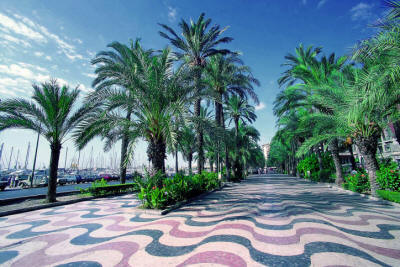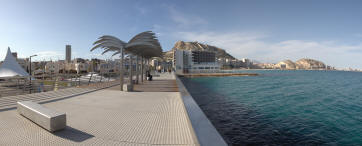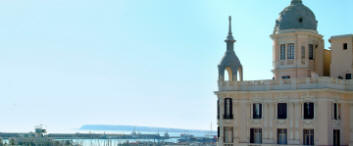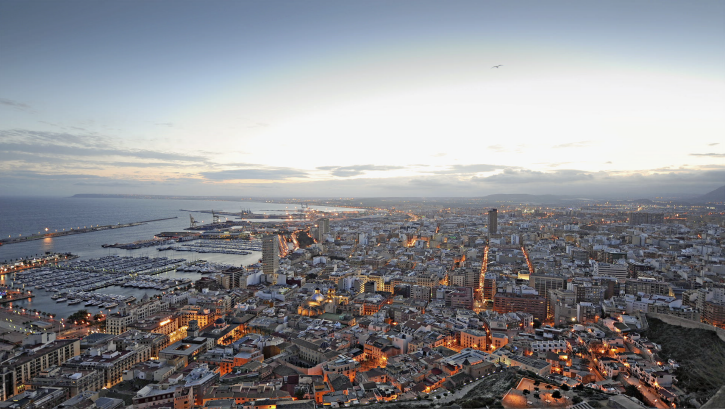 Alicante
is a port city on the Mediterranean coast.
It is the second largest city of the municipality of Valencia and eleventh
largest in Spain. Based on population it is the eighth-largest
metropolitan area of Spain.
Furthermore
Alicante is a center of
tourism.
Alicante
is a port city on the Mediterranean coast.
It is the second largest city of the municipality of Valencia and eleventh
largest in Spain. Based on population it is the eighth-largest
metropolitan area of Spain.
Furthermore
Alicante is a center of
tourism.
Alicante is a city with over 3000 years of history, as revealed by the
earliest archaeological remains found at the Cova del Fum cave in Fontcalent,
which dates back to the third millennium BC.
The earliest inhabited settlements were found on the hillside of Mount
Benacantil. It is believed that there has been Iberian population back then.
The earliest town as such dates back to the 4th century BC, when Tossal de
Manises first became home to the Ibero-Roman colony of Lucentum.
After the Roman era the Moorish conquest
happened,
where the colony was relocated to the slopes of Mount Benacantil for
defensive reasons, creating the Vila Vella or Old Town.
After the town was captured for the Kingdom of Castille by the Infante
Alfonso in 1247 and he became King Alfonso X, The Wise, it came to be known
as Vila Nova, or the New Town.
In 1249, King Jaime II incorporated the town of Alicante into the Kingdom of
Valencia and two centuries later, in 1490, Ferdinand the Catholic King
granted Alicante the status of city.
In the 19th century progress arrived in the city when the Alicante-Madrid
railway was built, the street lighting was installed and the planning of the
new town regulations started which would eliminate the walls and create new
neighborhoods.
In the 20th century the bonfire celebrations known as the Hogueras de San
Juan, which are officially declared as Interest to International Tourism,
were established then. The University was opened and in 1993 the city was
selected as the headquarters of the European Office of Harmonisation for the
Internal Market (OHIM), the EU's largest independent agency.


Alicante has an arid Mediterranean climate with mild temperatures throughout
the year and little rain, concentrated in equinoctial periods.
Temperatures range between 16.8 º and 6.2 º in January and 30.6 ° and 20.4 °
in
August, therefore an average annual temperature of 17.8 º. The daily
temperature variation is very small because of the maritime influence,
although occasional episodes of westerly winds can exceed 15 º. Regarding
the annual oscillation, the winters are mild and summers are hot.
The local gastronomy is undoubtedly one of Alicante's most renowned tourist
attractions.
Alicante's cuisine is typically Mediterranean. The history of Alicante, its
geographical location, the climate and the fertility of its lands add
richness and variety to this region's gastronomy.
Rice, the basic ingredient of all of the region's cuisine, plays a leading
role in a huge variety of recipes, although many other ingredients are also
used in the preparation of traditional meals.

Santa Bárbara Castle
On top of Mount Benacantil, at a height of 116 metres, stands one of Spain's
largest mediaeval fortresses, providing great views of Alicante's perfect
bay.
The Town Hall
This baroque civil building was designed by architect Lorenzo Chápuli
and erected on the site of the former town hall in the 18th century. The
main ornamental features that visitors always admire are the barley-sugar
columns on the facade and the two towers. Inside there are several
interesting rooms such as the Salón Azul, styled from the period of Spain's
Queen Isabel, the Salón de Plenos and a chapel in which masses are held.
The San Nicolás Co-Cathedral
The construction of San Nicolás Co-Cathedral began in the year 1600,
replacing a building that had stood their previously. It is built in the
Herrerian renaissance style and is located in the heart of the city.
The Santa María Basilica
This is the oldest church in the city, dating back to the 14th century.
It was built upon the ruins of Alicante's largest mosque and has a single,
non-cruciform nave with side chapels between the buttresses.
The Santa Faz Monastery
In a baroque style, this monastery stands in the municipal district of
Santa Faz, just five kilometers away from the city limits.
Alicante Provincial Council
The Council is located in a neo-classical palace designed by Juan Vidal
Ramos and built in 1928.
Alicante Theatre
Opened in 1847, this is a theatre par excellence. Its main facade is in
the neo-classical style, while its interior, designed in accordance with the
Italian typology of the period, is divided into three clearly differentiated
areas: the vestibule, the horseshoe-shaped auditorium and the stage.
Maisonnave Palace
Located in the street called Calle Labradores, this building dates back
to the 16th century. Inside, visitors will find the City Archives and a
display of the ruins of a late-Roman necropolis.
The Central Market
This building with its modernist-inspired elements was built under the
supervision of J. Vidal Ramos between 1911 and 1912, over the 18th century
walls that surrounded Alicante. It has a rectangular floor plan in the style
of a basilica, with a circular appendage in the south-west corner topped by
a semispherical cupola "La Rotonda". One of its two stories is a
half-basement due to the incline of the surrounding streets.
The Santa Cruz Hermitage
It stands on the slopes of Mount Benacantil, in the picturesque Santa
Cruz neighbourhood.
The Edificio Carbonell Building
Casa Carbonell is Number 1 on La Explanada de España, and is one of the
most striking buildings in Alicante. Built by J. Vidal Ramos between 1922
and 1925, Casa Carbonell is said to have been constructed upon the orders of
a textiles manufacturer from the nearby town of Alcoy, Enrique Carbonell.
The building bears testimony to the wealth of the Alcoy textiles
manufacturers during World War One.
The Las Agustinas Convent
Located in the city's Old District, this convent was built in the 18th
century to house Jesuits. Inside, visitors will find an image of Virgen de
la Soledad - the oldest image included in Alicante's Holy Week celebrations.
San Roque Hermitage
Located in the San Roque District, this hermitage was built in the 16th
century and was restored at the end of the 19th century.
The MARQ Provincial Archaeology Museum
Created in 1932, this museum was originally located on the ground floor of
the Provincial Council building on Avenida de la Estación in Alicante. In
2002, it was transferred to the former site of the San Juan de Dios
provincial hospital.
MUBAG, Gravina Fine Arts Museum
This museum occupies the 18th century Gravina Palace, which once
belonged to the Count of Lumiares and housed the Provincial Archives. It
exhibits works owned by the Provincial Council of Alicante, with collections
comprising works of art created in Alicante from the Middle Ages to the
early 20th century.
Fogueres Festival Museum
Here, you can explore the evolution of Alicante's most representative
festival, the Hogueras de San Juan bonfire celebration held in June, which
has been officially declared to be of International Tourist Interest.
Nativity Scene Museum
This museum is located in a typical traditional house in the city's Old
District. It is home to a permanent exhibition of nativity scenes in homage
to the great nativity scene tradition of Spain and various other countries
around the world and its collection features several international pieces.
The Bullfighting Museum
It is housed in one of the buildings that form part of the city's
bullring on the square known as Plaza de España.
Alicante Water Museum
Located in one of the Old District’s traditional squares, the Plaza del
Puente, it is alongside one of the entrances to La Ereta park on the slopes
of Mount Benacantil, which is topped by the Santa Bárbara Castle.
MUA, University of Alicante Museum
Devoted to contemporary art, this museum was opened in December 1999 and
is located on the campus of the University of Alicante in the nearby town of
San Vicente del Raspeig. It is the only museum as such to be housed on a
university campus.
Lucentum Archaeological Site
Located just 3 kilometres from the city centre, in the area known as
Tossal de Manises, are the major archaeological remains of the Roman city of
Lucentum or ancient Alicante, which are an important reference point for the
Ibero-Roman period.
The MACA Contemporary Art Museum
This museum is housed in the city's oldest surviving civil building. In
the baroque style, it dates back to 1685 and is located next to the Santa
María basilica. It was originally designed as a cereals warehouse but was
also used as a business school before finally becoming a museum.
Museo de la Ciudad de Alicante (MUSA)
The new Museo de la Ciudad de Alicante (Alicante City Museum) (MUSA), in
the fortress of Santa Bárbara, is spread out over five rooms. The ensemble
also includes an aljibe, a water tank from the Renaissance period, and a
Video room, screening a video about the "Espacio del dolor" (Painful Space-
the dungeons).
Las Cigarreras Cultural Centre
The popular tobacco factory was established at the beginning of the 19th
century and is an outstanding example of the area´s architectural urban
heritage. As a prime source of employment for thousands of workers over two
centuries, it forms part of the collective memory for several generations of
Alicante citizens. When tobacco production was transferred to the
surrounding suburbs, the old factory was taken over by the town council. The
restoration project for three of the factory warehouses, where Las
Cigarreras Cultural Centre is currently housed, has transformed this place
into a prominent Spanish cultural venue.
City Buses
Alicante has a substantial network of bus routes connecting all of the
points in the city and its metropolitan area. There are bus stops at key
locations: the RENFE train station, the bus station, the El Altet
international airport, shopping centres, squares such as La Plaza de los
Luceros and La Plaza del Mar, the Central Market, etc.
The buses run at frequent intervals from morning to night. At weekends, this
timetable is extended into the small hours of the morning on some routes,
particularly those running between Alicante and the outskirts of the city.
The TRAM
This service runs along several routes and is currently being extended.
Moving with TRAM
-
Line 1 ALICANTE (Luceros) - BENIDORM (change to Line 9 - Destination
ALTEA-DENIA)
-
Line 3 ALICANTE (Luceros) - El Campello
-
Line 4 ALICANTE (Luceros) - PLAYA SAN JUAN (A Coruña)
-
Line 4L ALICANTE (Puerta del Mar) - Sangueta. Change to lines 1-3-4
-
Line 9-DENIA BENIDORM (change to line 1. Destination ALICANTE)
Alicante Airport
The Airport of Alicante is located just 9 km southwest of the city, within
the boundaries of the town of Elche, and is run by Aena, the Spanish
aviation and airspace authority.
The airport can be accessed along the A-7 motorway and the N-332 dual
carriageway, with the average journey time of around 15 minutes from
Alicante city centre rising to 30 minutes during rush hour.
- Railway
Currently there are 3 lines that connect the city with its surroundings and
nearby towns:
• Alicante-Denia (connects the city to the center of Benidorm through other
coastal towns)
• Alicante-Murcia (line C-1-operator Renfe)
• Vicente del Raspeig Alicante-Universidad/San (line C-3-operator Renfe).
Besides commuter lines, Alicante also has several long distance lines:
• Euromed Train: Alicante-Valencia-Barcelona.
• Alvia Train: Alicante-Madrid.
Top